October 30th, 2007
An Angel holding a sundial with the date 1528 resides on Chartres Cathedral’s South side of the south tower of west façade, with two other sculptures in the ‘miscellaneous’ category: an ass playing a lyre (an illustration of the Latin saying “Asinus ad Lyram” which is the term for an awkward person) and a sow spinning. The angel is a twentieth century reproduction- the original is in the crypt.

October 29th, 2007
Wildrik Botjes completed his home planetarium in 1868 after 15 years of construction. He was a watchmaker and goldsmith, and lived in The Netherlands. The planetarium passed from person to person in his family, and now resides at Calvin College in Grand Rapids, Michigan, where it was restored and functions today.

October 19th, 2007
Between 1774 and 1781 Eise Eisinga built a solar system model into his living room ceiling in the province of Friesland, The Netherlands.
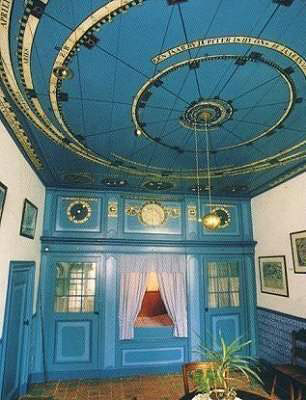
All the planets in Eisinga’s model orbit the sun at the same speed as do the real planets: Mercury in 88 days, the earth in one year, and Saturn in more than 29 years. It is the oldest still-working model—he left drawings explanations and instructions, including:
- Don’t forget to set the date ring correctly on the leap day.
- Check the speed of the clock during sudden temperature changes.
- Adjust the orbit of Saturn every year because I made a little miscalculation.
- Don’t forget to paint new year numbers every 22 years.
September 30th, 2007
In Athens, Greece not far from the famed Parthenon stands a structure known as the “Tower of the Winds.” Constructed around 50 BCE, by the Greek architect and astronomer Andronikos of Kyrrhos, it combined 9 sundials, a complicated internal water clock, and a weathervane many historians cite as the first ever built. The octagonal, white marble tower stands over 46 feet high with a diameter of about 26 feet, resting on a base of three steps.
The Tower was originally topped by a revolving bronze weather vane which we know from historical records to have been of the sea god Triton, who had the head and torso of a man and the tail of a fish. A pointed wand in his hand indicated the direction from which the wind was blowing. More info on wikipedia and the weather journal.
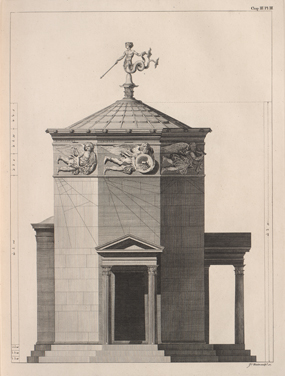
September 19th, 2007
The Tower of Radkan is a solar observatory built in 1261AD by Khajeh Nasir Tusi’s group in Iran. Extensive information on how it works is available at www.jamejamshid.com.
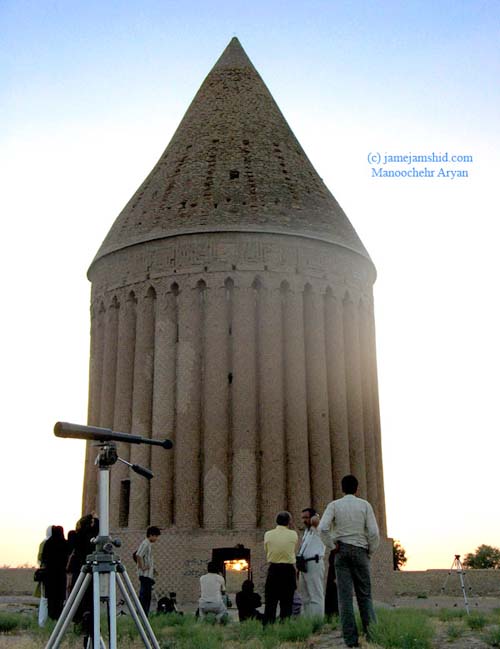
September 17th, 2007
Between 1727 and 1734 Maharajah Jai Singh II of Jaipur constructed five astronomical observatories in west central India. The observatories, or “Jantar Mantars”, incorporate multiple buildings of unique form, each with a specialized function for astronomical measurement, and which are fantastic sculptures in their own right. Visit the extensive documentary project initiated by Barry Perlus at Cornell U. for excellent interactive panoramic ‘VR’ photos, time lapse sequences, 3D models, ‘spherical rendering’ photographs, and lots of other research.
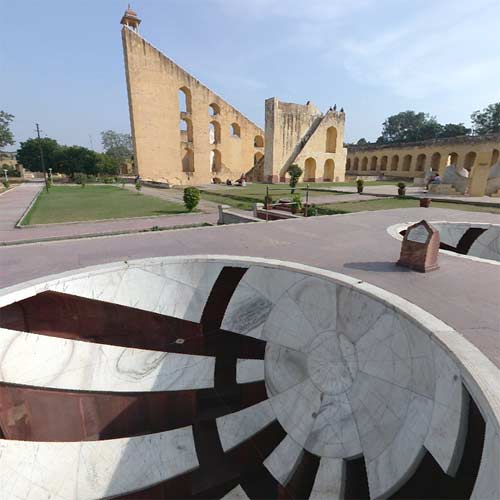
[photo-Perlus, capture from VR photo ‘Jai Prakash’]
September 12th, 2007
Uraniborg proved drafty, which disturbed instrument accuracy, and so Tycho Brahe designed and built a largely underground observatory next door to Uraniborg in 1584.
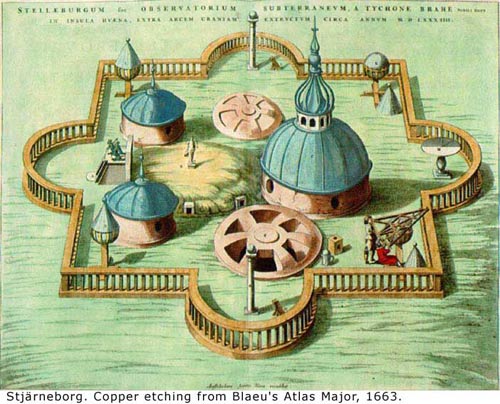
Stjerneborg now-ish:
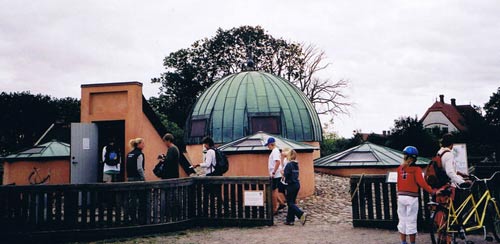
More info: www.tychobrahe.com
September 11th, 2007
Operated by Tycho Brahe in the late 1500s, Uraniborg was the first building ever designed with astronomical observations as its primary design criteria. The towers and balconies were to serve as instrument platforms, and the rooms in the main building were to house Tycho and his family, visiting astronomers, visiting royalty, and students. The alchemical laboratory was in the basement. The orientation of the building was chosen for maximum coverage of the sky with the instruments. Uraniborg was located in the very middle of large walled an intricate garden–In addition to being decorative, the gardens also supplied herbs for the Tycho’s medicinal chemistry experiments. Note sundial in garden, left of castle. More info.
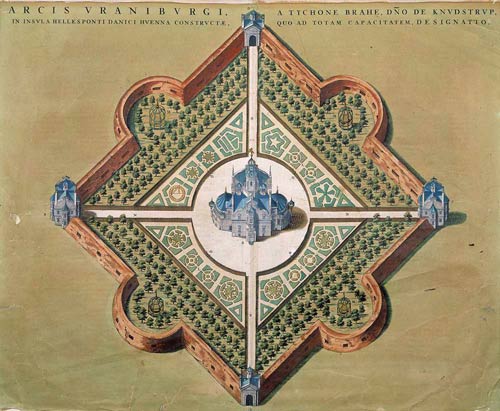
August 28th, 2007
NEIGHBORHOOD REPORT: LONG ISLAND CITY; Controversy Died Down; Wind Hasn’t
By BRUCE LAMBERT
Published: February 6, 1994, The New York Times
Citicorp’s tower, an impressive skyscraper, sometimes sweeps people off their feet — literally. Powerful winds sporadically swirling around it actually lift unwary pedestrians off the ground, neighbors say.
“I know it’s hard to believe, but people get blown into midair,” said Susan P. Chetwin, general manager of the Muzak office across the street on Jackson Avenue. Her workers regularly use the tower for its Citibank branch and basement subway stop.
Jean McIntyre, describing a daily bank errand for Muzak, said, “the wind picked me up completely off the sidewalk — this is no exaggeration — and I was just flying through the air.” She was lifted several inches off the ground and flung about 20 feet away, she estimates.
“It felt like I was going 30 miles an hour. I was headed for a glass window, so I managed to throw myself to the ground to prevent that. I hurt my shoulder, hip and head. I was dazed for a while. I could have been killed there.”
Just what is causing the turbulence is unclear. A Citicorp spokesman said, however, that the company took precautions recently by temporarily closing one entrance, posting warnings and putting up a rope railing; further measures are being studied.
Speaking without specific knowledge of the Citicorp situation, experts noted that wind striking skyscrapers can create strong drafts. Irwin G. Cantor, a structural engineer specializing in tall buildings, said that scientists can make a model of a building and its surroundings, then measure air flow in a wind tunnel “to learn where the hot spots are.” Installing planters or trees might help buffer the wind, he said.
Writing to Citicorp on Jan. 4 about turbulence that day, Ms. Chetwin said three workers were swept off their feet, including one who “was blown into a pole and slightly injured and has gone home for the day.” An earlier letter described a woman being hurled beneath a standing car.
Citicorp should erect a covered walkway or handrail, she wrote the company. Citicorp wrote back that the matter was being reviewed.
Although Muzak’s office is only a few hundred feet from the tower, on windy days its staff often ferries people back and forth by car. “Maybe if I had fatter employees,” Ms. Chetwin said, “this wouldn’t be such a problem.” B.L.
July 29th, 2007

Rockefeller Center, opposite St. Patrick’s Cathedral on 5th Ave. in NYC.
Lee Lawrie and Rene Chambellan, installed in 1937.
From The Art of Rockefeller Center by Christine Roussel:
“Atlas had waged and lost a ten-year war against the gods of Mount Olympus. As punishment, the gods condemned Atlas to support the earth and the heavens on his back for eternity. He had grown weary of the task and was only too glad when Hercules offered to take over his burden. In turn, Hercules said he needed help to complete his eleventh labor, fetching the Golden Apples, which were closely guarded by nymphs called the Hesperides. Prometheus had told Hercules that Atlas could easily complete this labor as he was the nymphs’ father and knew their secrets. When Atlas returned with the apples, Hercules tricked him into resuming the burden of bearing the earth and the heavens on his back for eternity. This statue depicts that never-ending punishment.
The twenty-one-foot-diameter, openwork sphere bears the signs of the zodiac, and its axis points to the North Star. . . . The celestial sphere indicates the earth’s path around the sun, the change of the earth’s axis on its orbit, and the equinoxes.”









